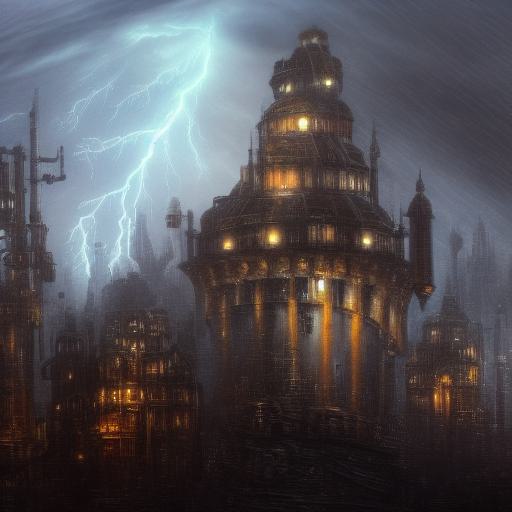How to write this prompt?
First, let’s break down the prompt into its individual parts and see how each part influences the image being generated:
- “Melancholic”: This word sets the overall mood of the image, indicating that it should be somewhat sad or pensive. This could manifest in a number of ways, such as dark colors, gloomy weather, or a sense of isolation or despair in the subject matter.
- “Steampunk art”: Steampunk is a subgenre of science fiction that combines Victorian-era aesthetics with futuristic technology. This gives the image a unique visual style, with elements like gears, clockwork, and brass pipes.
- “A painting of a mechanical city on top of a mountain with many gears and metallic components”: This is the core of the image, describing the setting and main subject matter. The mechanical city on top of a mountain suggests a sense of isolation or inaccessibility, while the many gears and metallic components reinforce the steampunk aesthetic.
- “In thunderstorm and rain”: This sets the weather conditions for the image, adding a sense of drama and intensity. The thunderstorm and rain could be depicted in a variety of ways, such as dark clouds, lightning bolts, and heavy raindrops.
- “Concept art inspired by Brian Despain, Artstation contest winner”: This is a specific reference to an artist who specializes in creating steampunk-inspired artwork. By referencing their work, the prompt is providing a visual reference for the style and tone of the image.
- “Very far royal steampunk castle”: This adds an additional element to the image, suggesting a larger world or context in which the mechanical city exists. The use of the word “royal” suggests a sense of grandeur or importance, while the steampunk castle reinforces the aesthetic.
- “Science fantasy painting”: This is a broader genre reference, indicating that the image should combine elements of science fiction and fantasy. This could include elements like magic, mythical creatures, or futuristic technology.
- “Steampunk villages castles”: This is another reference to the larger world of the image, suggesting that there are other steampunk-inspired settlements in the area. This could be useful for creating a sense of scale or context for the mechanical city on top of the mountain.
Taken together, these individual parts create a detailed and specific prompt for generating an AI image. By carefully selecting each element and considering how it contributes to the overall image, it’s possible to create a unique and compelling piece of artwork that meets the desired specifications.
Where did steampunk art originate from?
Steampunk art originated from a subgenre of science fiction literature in the 1980s that combined Victorian-era aesthetics with futuristic technology. It has since expanded into a broader cultural movement encompassing fashion, design, and visual arts. The steampunk aesthetic draws inspiration from the steam-powered machinery of the Industrial Revolution, with an emphasis on gears, clockwork, and brass pipes.
What are the essential graphical elements in steampunk art?
The essential graphical elements in steampunk art include mechanical components such as gears, cogs, and pipes, as well as a focus on metallic textures and colors. Other common elements include Victorian-era clothing and architecture, airships, and steam-powered vehicles. The overall aesthetic is characterized by a sense of nostalgia for a bygone era, coupled with a fascination with futuristic technology.
Who is Brian Despain?
Brian Despain is an artist who specializes in creating steampunk-inspired artwork. He has won several awards for his work, including the Artstation Steampunk Challenge in 2015. Despain’s artwork often features fantastical machines and creatures, with a focus on intricate details and textures.
How does AI arts generation contribute to our global economy?
AI arts generation has the potential to contribute to the global economy in several ways. For one, it can provide a new avenue for artists and designers to create and sell their work. Additionally, it can be used in industries such as advertising and marketing to create visually appealing graphics and animations. Finally, AI arts generation can lead to advancements in fields such as computer vision and machine learning, which have applications in many different industries.
How can people make a living out of AI arts generation?
There are several ways people can make a living out of AI arts generation. One is to create and sell their own AI-generated artwork through online marketplaces such as NFT platforms. Another is to offer AI-generated graphics and animations as part of their design services, whether through freelance work or a design agency. Finally, people can work on developing and refining the AI algorithms used to generate artwork, either as part of a research team or through their own startup.
Visual Paradigm Online is a design tool that allows users to easily incorporate AI-generated art into their designs. With its user-friendly interface, range of design templates and assets, and easy-to-use design tools, Visual Paradigm Online makes it simple to create stunning and visually appealing graphics with just a few clicks. Whether you’re looking to experiment with different styles and layouts or create eye-catching designs for your business or personal projects, Visual Paradigm Online is an excellent choice for bringing your creative vision to life.


